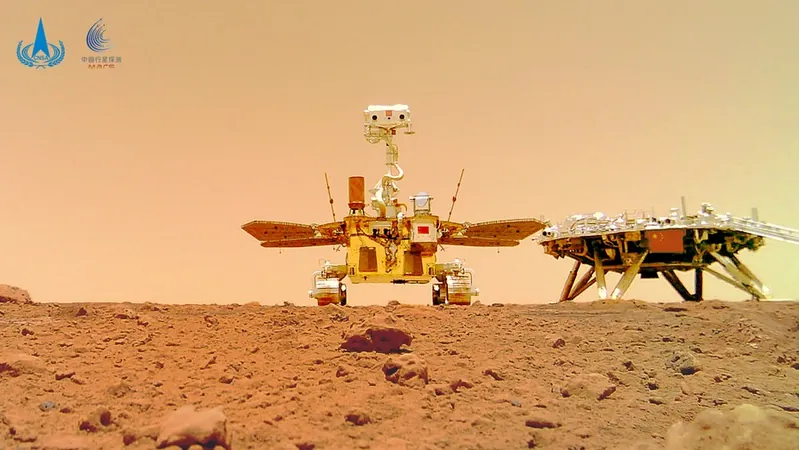
China's Bold Space Ambitions: A Potential Rival to NASA Amidst Budget Cuts
2025-03-27
Author: Ying
In an era where space exploration is becoming increasingly competitive, China's newly established Deep Space Exploration Laboratory is setting its sights on ambitious missions across the Solar System. This initiative, launched three years ago in eastern China, near Shanghai, marks a strategic collaboration between China's national space agency and the University of Science and Technology of China.
Recently, the lab has unveiled an audacious roadmap for its future missions, igniting discussions on whether this could reshape the landscape of planetary exploration, traditionally dominated by NASA. Key highlights from their ambitious agenda include:
Upcoming Missions
2028: Launch of the Tianwen-3 mission to collect and return Martian soil and rock samples to Earth.
2029: The Tianwen-4 mission, aimed at exploring Jupiter and its moon Callisto.
2030: Development of a large-ground habitat to simulate long-duration human spaceflight.
2033: A mission to Venus, focusing on retrieving atmospheric samples.
2038: Establishment of an autonomous research station on Mars to investigate in-situ resource utilization.
2039: An exploratory mission to Triton, Neptune's largest moon, featuring a subsurface explorer to study its ocean.
These plans certainly raise eyebrows in the international space community, especially since only the Tianwen-3 and Tianwen-4 missions have received formal approval from the Chinese government. Some of these missions, particularly the Triton expedition, are fraught with uncertainty, raising questions about the feasibility of penetrating the moon's icy shell to access its ocean below.
However, China’s meticulous approach to its lunar exploration initiative has seen tangible successes. With its first mission to the Moon launched in 2007, the nation has showcased a series of successful robotic missions, including the historic retrieval of samples from the Moon's far side last summer. The Tianwen-1 mission to Mars, launched in 2020, solidified China’s prowess by successfully landing a rover, a feat only achieved previously by the United States.
As China propels forward in its space endeavors, NASA is facing potential budget cuts that could threaten its capabilities. Reports suggest dramatic reductions of up to 50% in science programs, including planetary exploration, which have been described as "extinction level" for the nation's space science efforts. This funding uncertainty opens the door for China to potentially overtake the United States in the race for space exploration supremacy.
The stakes are high; while China's aspirations may be subject to potential setbacks, failures could equally temper their ambitions. With the nation's government leveraging space exploration as a projection of soft power, maintaining a successful program is vital to engender public and international support.
Moreover, China is not stopping at robotic missions; it is working to land astronauts on the Moon by 2030 in a parallel human lunar initiative. This multifaceted approach demands robust financial backing, raising questions about how far China is willing to invest in its space programs.
Simultaneously, the U.S. Congress is poised to resist drastic cuts in NASA's planetary initiatives, suggesting that the future of U.S. space exploration may not be as bleak as some speculate. With private companies innovating in satellite technology, the prospect of reduced costs for various missions could enable NASA to sustain its relevance in deep space exploration.
The future of space exploration is uncertain, yet it is clear that the dynamics are shifting. China’s burgeoning ambitions and NASA's established legacy could soon find themselves in direct competition, marking a new chapter in humanity's quest for knowledge beyond Earth. The race for the stars has never been closer!




 Brasil (PT)
Brasil (PT)
 Canada (EN)
Canada (EN)
 Chile (ES)
Chile (ES)
 Česko (CS)
Česko (CS)
 대한민국 (KO)
대한민국 (KO)
 España (ES)
España (ES)
 France (FR)
France (FR)
 Hong Kong (EN)
Hong Kong (EN)
 Italia (IT)
Italia (IT)
 日本 (JA)
日本 (JA)
 Magyarország (HU)
Magyarország (HU)
 Norge (NO)
Norge (NO)
 Polska (PL)
Polska (PL)
 Schweiz (DE)
Schweiz (DE)
 Singapore (EN)
Singapore (EN)
 Sverige (SV)
Sverige (SV)
 Suomi (FI)
Suomi (FI)
 Türkiye (TR)
Türkiye (TR)
 الإمارات العربية المتحدة (AR)
الإمارات العربية المتحدة (AR)